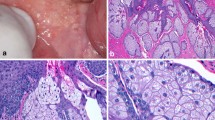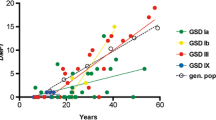Abstract
The objectives are to precisely identify the cells that incite the formation of lesions that are generally known as “pulse granuloma” or “hyaline ring granuloma” that occur mostly in the oral cavity, in the lungs, in and around the gastrointestinal tract, and other sites, and to suggest an alternative name for these lesions that accurately reflects their etiology. Critical review of the medical and dental literature was undertaken, and the microscopic appearances of granuloma-inciting cells depicted in the literature and seen in our practices were compared with seeds and their contents originating from a variety of leguminous and non-leguminous plants. Sections of selected seeds were examined microscopically before and after digestion with saliva and alpha amylase and subsequent routine processing and staining with H&E, PAS, and iodine. Pre- and post-digestion slides were examined with polarized light. The morphology of the granuloma-inciting cells is identical to the storage cells present in seeds from a variety of leguminous and non-leguminous plants. The cells that trigger the formation of “pulse granulomas”/“hyaline ring granulomas” are storage cells that are derived from ingested seeds of leguminous and non-leguminous plants. The terms “pulse,” “legume,” and “lentil,” which have been applied to these cells, are misnomers. Our findings indicate that the terms “pulse granuloma” and “hyaline ring granuloma” are not appropriate descriptors of these lesions. We recommend that they be replaced by “seed storage cell granuloma,” a term that now accurately reflects the etiology of these lesions.








Similar content being viewed by others
References
Talacko AA, Radden BG (1988) Oral pulse granuloma: clinical and histopathological features. A review of 62 cases. Int J Oral Maxillofac Surg 17:343–346. https://doi.org/10.1016/s0901-5027(88)80059-6
Philipsen HP, Reichart PA (2010) Pulse or hyaline ring granuloma. Review of the literature on etiopathogenesis of oral and extraoral lesions. Clin Oral Investig 14:121–128. https://doi.org/10.1007/s00784-009-0322-0
Kimura TC, Carneiro MC, Coelho YFS, de Sousa SCOM, Veltrini VC (2021) Hyaline ring granuloma of the mouth-a foreign-body reaction that dentists should be aware of: Critical review of literature and histochemical/immunohistochemical study of a new case. Oral Dis 27:391–403. https://doi.org/10.1111/odi.13287
Head MA (1956) Foreign body reaction to inhalation of lentil soup: giant cell pneumonia. J Clin Pathol 9:295–299. https://doi.org/10.1136/jcp.9.4.295
Knoblich R (1969) Pulmonary granulomatosis caused by vegetable particles. So-called lentil pulse pneumonia. Am Rev Respir Dis 99(3):380–389
Mukhopadhyay S, Katzenstein AL (2007) Pulmonary disease due to aspiration of food and other particulate matter: a clinicopathologic study of 59 cases diagnosed on biopsy or resection specimens. Am J Surg Pathol 31:752–759. https://doi.org/10.1097/01.pas.0000213418.08009.f9
Nowacki NB, Arnold MA, Frankel WL et al (2015) Gastrointestinal tract-derived pulse granulomata: clues to an underrecognized pseudotumor. Am J Surg Pathol 39:84–92. https://doi.org/10.1097/PAS.0000000000000308
Gonzalez RS (2016) Incidence of pulse granuloma in the small and large Intestines. Am J Surg Pathol 40:137–140. https://doi.org/10.1097/PAS.0000000000000572
Anna University, Chennai, India (2018) Pulses. http://brainkart.com/article/Pulses_38305. Accessed 7 April 2021
Global Pulse Confederation (2015) A brief history of pulses. https://pulses.org/what-are-pulses/a-brief-history-of-pulses. Accessed 21 April 2021
United Nations Food and Agriculture Organization (1994) Pulses and derived products. Definition and classification of commodities. http://fao.org/es/faodef/fdef04e.htm. Accessed 22 March 2021
Chou L, Ficarra G, Hansen LS (1990) Hyaline ring granuloma: a distinct oral entity. Oral Surg Oral Med Oral Pathol 70:318–324. https://doi.org/10.1016/0030-4220(90)90148-l
Barnard WG (1940) Elementary Pathological Histology, 2nd edn. Lewis, London, p p10
Muir R (1929) Text-Book of Pathology.2nd ed. Arnold. London (cited by Head [4])
Lewars PH (1971) Chronic periostitis in the mandible underneath artificial dentures. Br J Oral Surg 8:264–269. https://doi.org/10.1016/s0007-117x(70)80089-0
Adkins KF (1972) Granulomas in edentulous jaws. N Z Dent J 68:209–212
Dunlap CL, Barker BF (1977) Giant-cell hyalin angiopathy. Oral Surg Oral Med Oral Pathol 44:587–591. https://doi.org/10.1016/0030-4220(77)90302-4
King OH (1978) “Giant cell hyaline angiopathy”: pulse granuloma by another name? Program Abstract No. 10. Thirty -second Annual Meeting of the American Academy of Oral Pathology. Fort Lauderdale, Florida, April 23-29. (Cited by Chou [11])
Sherman FE, Moran TJ (1954) Granulomas of stomach. 1. Response to injury of muscle and fibrous tissue of wall of human stomach. Am J Clin Pathol 24:415–421. https://doi.org/10.1093/ajcp/24.4.415
Talacko AA, Radden BG (1988) The pathogenesis of oral pulse granuloma: an animal model. J Oral Pathol 17:99–105. https://doi.org/10.1111/j.1600-0714.1988.tb01894.x
Harrison JD, Martin IC (1986) Oral vegetable granuloma: ultrastructural and histological study. J Oral Pathol 15:322–326. https://doi.org/10.1111/j.1600-0714.1986.tb00633.x
Scivetti M, Lucchese A, Ficarra G, Giuliani M, Maiorano E, Favia G (2009) Oral pulse granuloma: histological findings by confocal laser scanning microscopy. Ultrastruct Pathol 33:155–159. https://doi.org/10.1080/01913120902976562
Gueiros LA, Santos Silva AR, Romañach MJ, Leon JE, Lopes MA, Jorge J (2008) Distinctive aspects of oral hyaline ring granulomas. Oral Surg Oral Med Oral Pathol Oral Radiol Endod 106:e35–e39. https://doi.org/10.1016/j.tripleo.2008.04.017
Razzano D, Gonzalez RS (2020) Disease, drugs, or dinner? Food histology can mimic drugs and parasites in the gastrointestinal tract. Virchows Arch 477:593–595. https://doi.org/10.1007/s00428-020-02793-w
Watson RE, Stewart C (1991) Experimental oral foreign body reactions: vegetable materials. Oral Surg Oral Med Oral Pathol 71:312–316. https://doi.org/10.1016/0030-4220(91)90306-w
Acknowledgements
We gratefully acknowledge the valuable assistance of Dr. Robert W. Seagull, Professor Emeritus of Biology at Hofstra University, Uniondale, NY, USA, who provided guidance on basic botanical issues and identified seed-derived storage cells in cytology and tissue specimens.
Technical assistance with photo editing by Nathan A. Rosen is gratefully acknowledged.
Author information
Authors and Affiliations
Contributions
Yale Rosen – formulated the concept for the article, prepared the original and subsequent drafts, searched the literature, contributed, and edited images.
Pascual Meseguer Garcia – reviewed the manuscript and suggested modifications, prepared slides from a variety of seeds, performed experiments on effects of salivary and alpha amylase digestion on various seeds, wrote a descriptions of his experiments, contributed and edited images, approved the final manuscript.
Pooja Navale – contributed images, reviewed the manuscript and suggested modifications, approved the final manuscript.
Corresponding author
Ethics declarations
Conflict of interest
The authors declare no competing interests.
Additional information
Publisher’s note
Springer Nature remains neutral with regard to jurisdictional claims in published maps and institutional affiliations.
Rights and permissions
About this article
Cite this article
Rosen, Y., Garcia, P.M. & Navale, P. Pulse/hyaline ring granuloma revisited: etiologic role of seed-derived storage cells. Virchows Arch 480, 499–508 (2022). https://doi.org/10.1007/s00428-021-03222-2
Received:
Revised:
Accepted:
Published:
Issue Date:
DOI: https://doi.org/10.1007/s00428-021-03222-2




